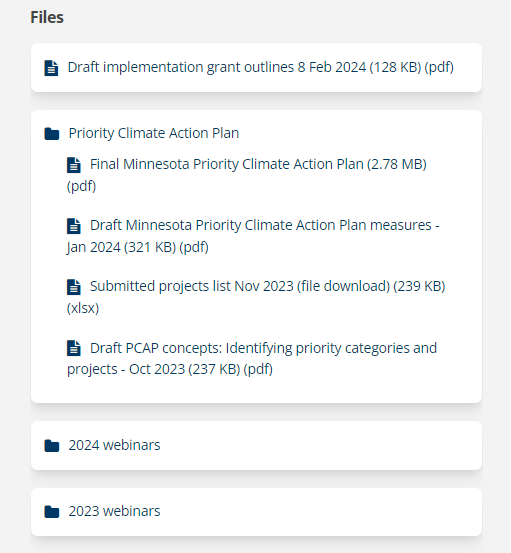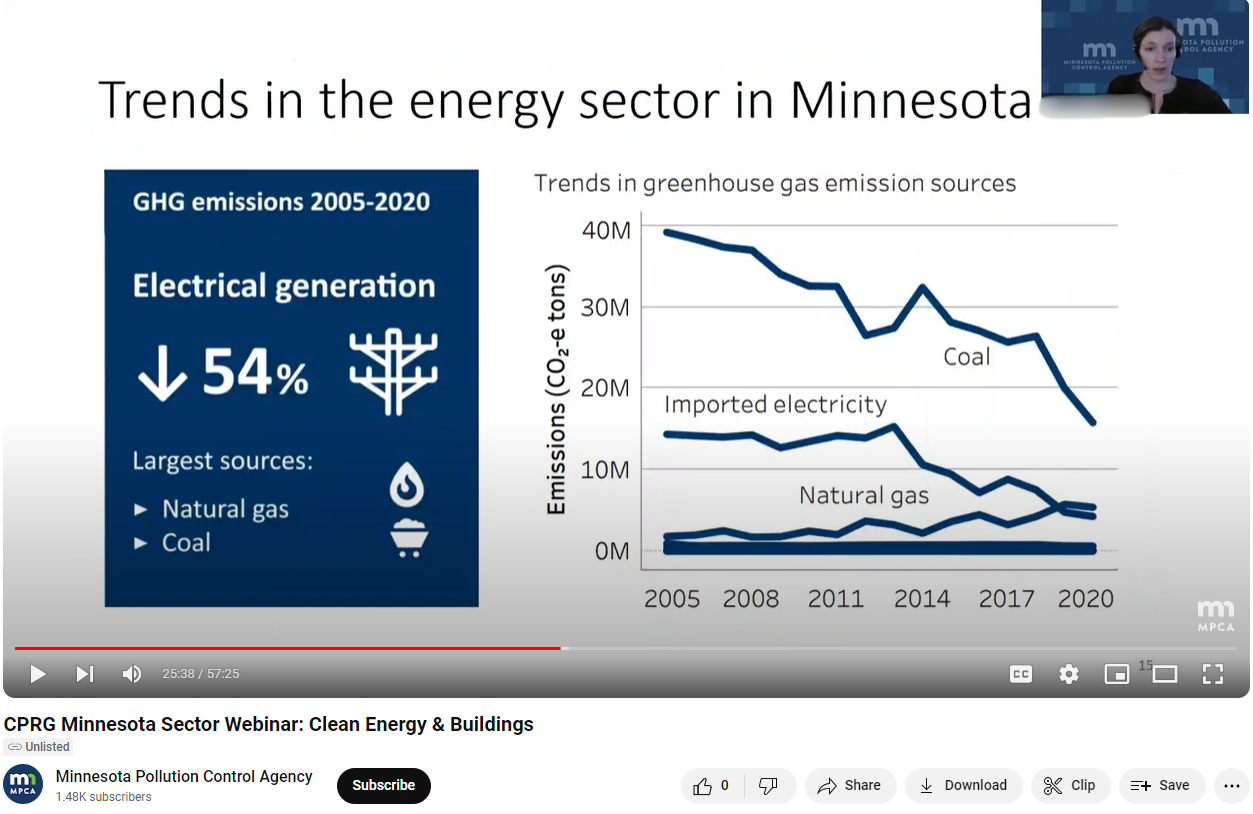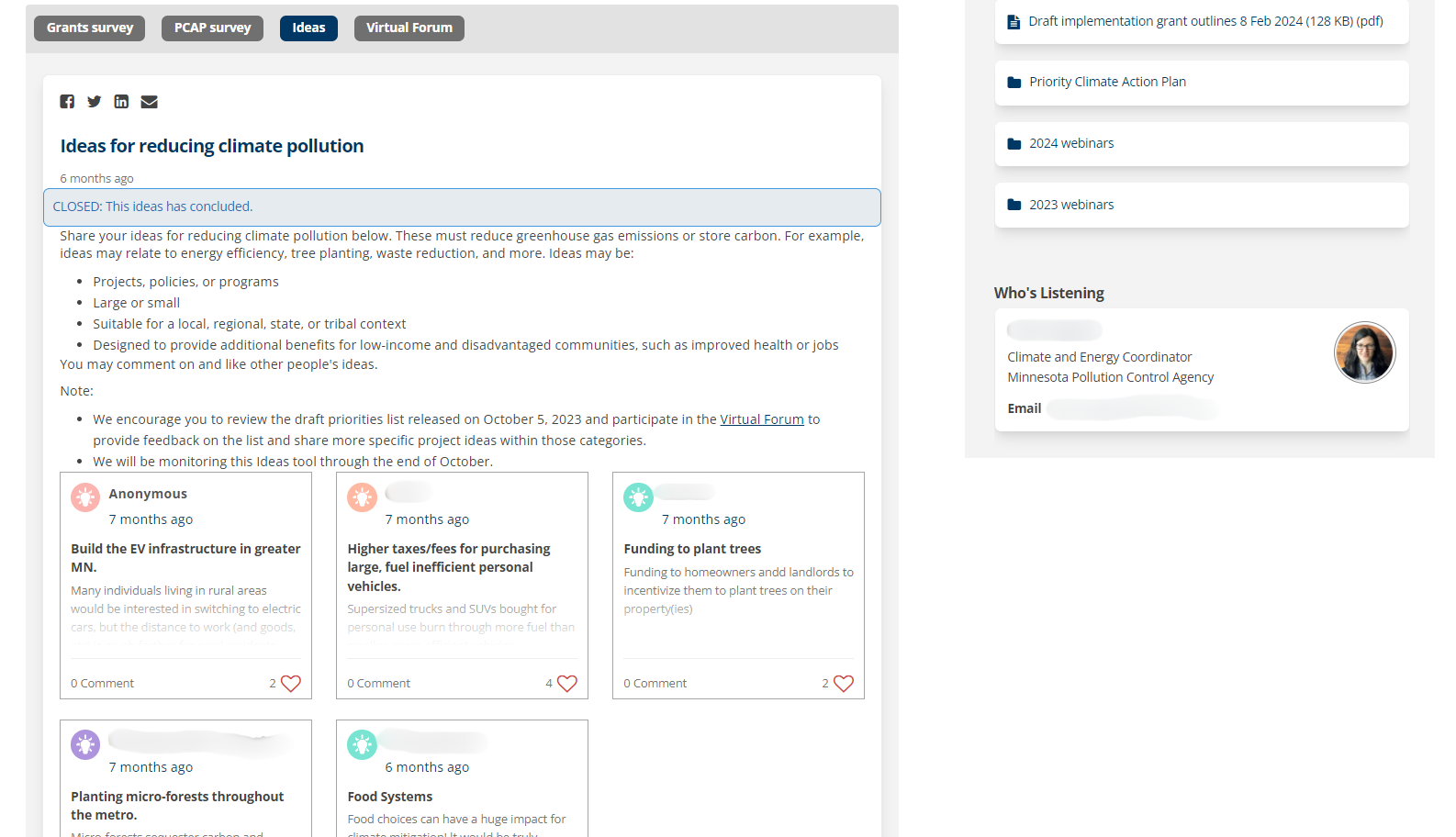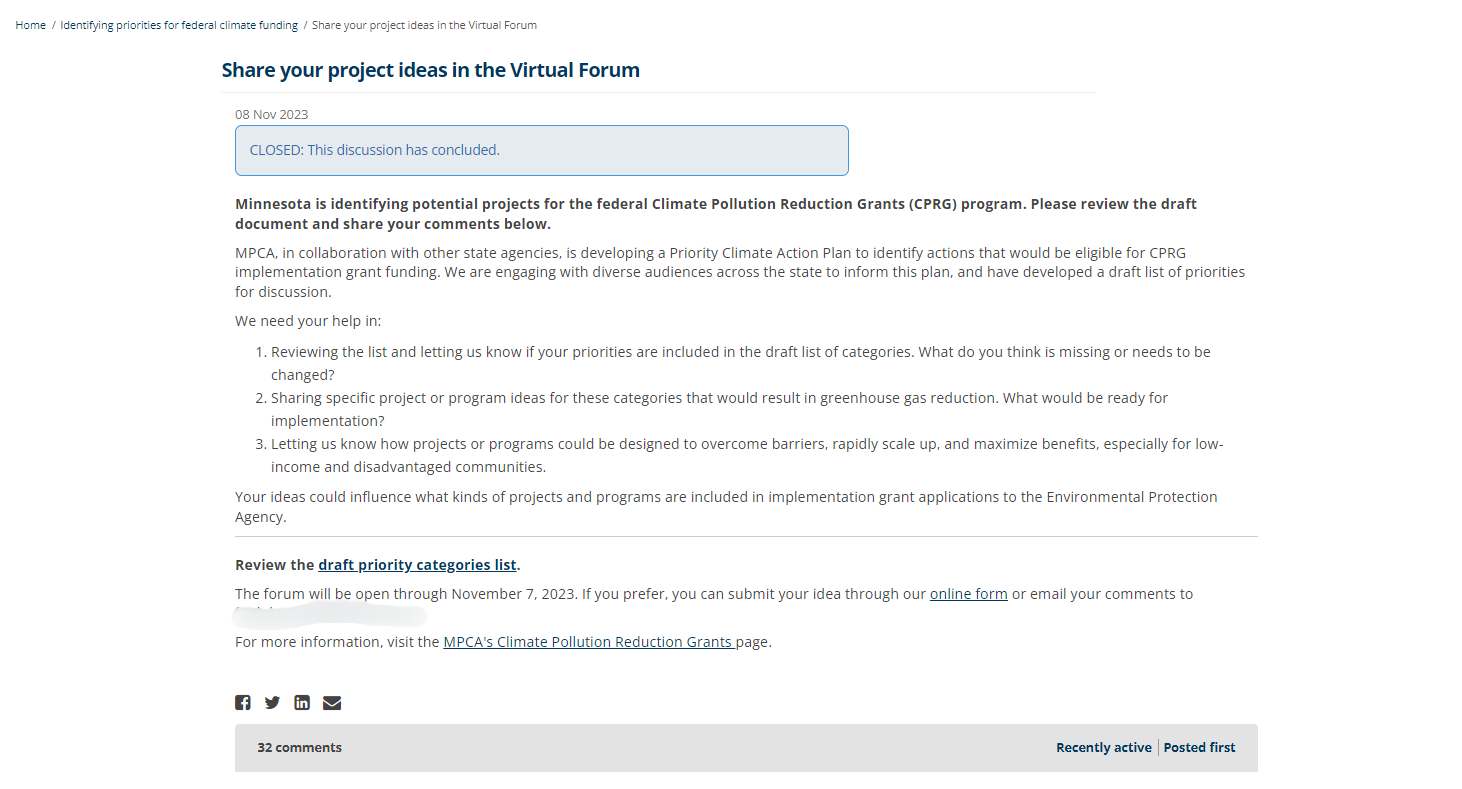flowchart TD
A[Secure Planning Grant] --> B
subgraph B [Develop Priority Climate Action Plan]
B1[Draft a List of Project Categories]
B1 --> B2[Identify Project & Program Ideas]
B2 --> B3[Choose, Refine, and Describe Ideas to Pursue]
end
B3 --> C[Develop Comprehensive Climate Action Plan]
C --> D[Apply for Implementation Grant]
Case 2: Minnesota Climate Action Planning
Our second case focuses on the Minnesota Pollution Control Agency's (MPCA) efforts to design and fund a climate pollution reduction project. As part of the Inflation Reduction Act, the U.S. Environmental Protection Agencies's Climate Pollution Reduction Grants (EPA CPRG) program was a $5 billion investment that provided states, local governments, and Tribal Nations with resources to implement projects that reduce greenhouse gas emissions and other harmful air pollution (Minnesota Environmental Quality Board, n.d.). In collaboration with other state agencies and stakeholders, the MPCA secured a planning grant in June 2023. The deliverables for this grant included a "Priority Climate Action Plan" (PCAP) that provided "a focused list of near-term, high-priority, implementation-ready measures to reduce climate pollution from greenhouse gas emissions" (Krogstad et al., 2024, p. 8).
The PCAP included a list of projects the agency would be ready to implement. Submitting the plan made the MPCA eligible to apply for an implementation grant, which would provide funding for one or more projects identified in a Priority Climate Action Plan.
The MPCA's process for writing that action plan is our focus in this case.
More specifically, we focus on the MPCA's engagement activities as implemented via a project-specific EngagementHQ webpage dedicated to “Identifying Priorities for Federal Climate Funding.”
Engagement HQ
EngagementHQ is a digital platform designed primarily for use by government agencies. The "all-in-one digital engagement platform" consists of a suite of features designed to help agencies plan and manage community engagement activities. Product descriptions and case studies of EngagementHQ emphasize its ability to promote two-way dialogue, using phrases like deliberative dialogue, open discussion, civil debate, conversation, and co-design (Granicus, n.d.).
EngagementHQ serves as something akin to a content management system where government communicators can design and facilitate communication. Agency communicators can provide project context on the landing page for the project. In this case, the landing page serves as a hub for the MPCA's efforts to secure a CPRG from the EPA.
The top of the landing page features text describing the details of the grant program, what the agency has already done, and what will happen next in the project. At the end of this text, readers are invited to sign up for email updates about the project or email a coordinator directly if they have questions. Links to share the page via email or popular social media platforms are also featured.
To the right, a graphic representation of the project lifecycle lists phases of the project and the estimated timeframe for each phase. Checkmark icons indicate which phases have been completed. Together, the project overview text and lifecycle panel provide high-level project context to orient participants.
A files repository allows government communicators to provide in-depth information and additional background. A files panel below the project lifecyle features a list of materials, including video recordings and associated slides from a series of webinars in which project facilitators provided project information and answered participant questions. These webinars in the file repository serve as a digital alternative or supplement to public meetings where project facilitators might brief community members on the project and seek input. In this case, these webinars serve as key moments to frame subsequent engagement around a set of shared, salient facts.
These webinars serve as a digital alternative or supplement to public meetings where project facilitators might brief community members on the project and seek input. In this case, these webinars serve as key moment to frame subsequent engagement around a set of shared, salient facts.
In addition to providing data, the agency directs participants to data sources they believe will be compelling to the funding agency. For example, they note that the EPA reviewers expect projects to have a positive impact on disadvantaged communities, as defined by Justice40 Initiative criteria and the Inflation Reduction Act's Disadvantaged Communities Map (Council on Environmental Quality, n.d.; EPA, 2023).
Participants are directed to access maps of disadvantaged communities in Minnesota via EJScreen, the EPA's Environmental Justice Screening and Mapping Tool (EPA, n.d.).
(Note: As of 2025, EJScreen has been removed from the EPA website. Public Environmental Data Partners [2025] has reconstructed an unofficial copy of Version 2.3 of the tool.)
Additional files are added throughout the project, such as an outline of potential ideas early in the project and a draft of the PCAP.
Survey
The MPCA used the survey feature to collect data on values and preferences to ostensibly inform which projects they move forward with and provide empirical support for those choices. They opened a survey to gather project ideas within the priority categories they identified. As they articulated in the final action plan, this "survey garnered over 350 submissions from local governments, community-based organizations, state agencies, academic institutions, businesses, and interested individuals, spanning from general ideas to detailed project proposals. These proposed projects… helped inform the measures that are now integrated into the PCAP" (Krogstad et al., 2024, p. 17).
Ideas Board
The team also used an "ideas board" to invite participants to share their ideas for reducing greenhouse gas emissions.
Unlike a survey response that goes directly to the MPCA, short "ideas" were posted to the board and become cards in a grid for other participants to read, like, share, or respond to.
Forum Board
The team also used a "forum board" to invite participants to share ideas. While the prompt was similar to the ideas board, this format was presumably better suited for more involved posts. Here again, participants were able to respond to others' posts.
Overall, we see the MPCA leveraging the features of EngagementHQ not only to provide participants with information in a variety of formats but also to facilitate exchange among participants. Beyond simply sharing climate science data, the platform's features support the collection of local knowledge and facilitate dialogue among stakeholders—essential elements of science2 as described by William Keith and Robert Danisch (2014).




